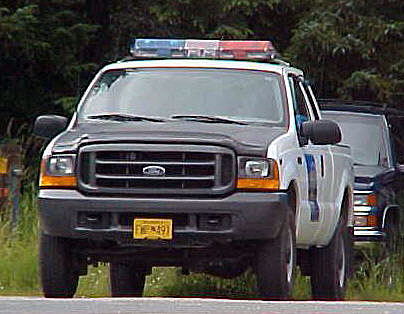ALASKA DPS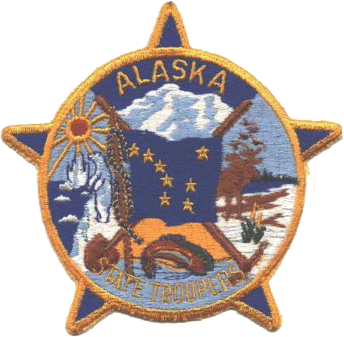
ALASKA DPS
In 1941 the Alaska Territorial Legislature established the Territory of Alaska Highway Patrol for the purpose of enforcing the traffic code - but did not provide the new organization with police authority. In 1945, the members of the Alaska Highway Patrol were deputized as Special Deputy U.S. Marshals. In 1948 the Highway Patrol was given the full authority of peace officers to enforce the laws of the Territory.
In 1953, the Territorial Legislature established the Alaska Territorial Police to provide law enforcement services for the entire Territory. In 1959, the name of Alaska's law enforcement agency was changed to the Alaska State Police and the organization became a division of the Department of Public Safety. The new State Police added 13 former U.S. Marshals and 10 new recruits to their ranks, increasing their number to 78 commissioned officers.
In 1967, the name was changed to the Alaska State
Troopers.
Today, the Alaska State Troopers number approximately
240 commissioned and 190 civilian personnel. The Troopers' major
components are five Detachments and a Criminal Investigation Bureau
(founded in 1971). The detachments are headquartered in Ketchikan,
Palmer, Anchorage, Fairbanks, and Soldotna.
Before even getting into the details surrounding this subject, I owe a great deal of credit for this information to a dear friend and fellow hobbyist, the late Earl Jenson of Polson Montana. Earl retired as an Alaska State Trooper back in the early 1980's after starting his law enforcement career with the Alaska Department of Commerce as a Commercial Vehicle Inspector and Weigh Scale Operator in the 1940's. Earl was a man of details and he documented for the subject of motor vehicle registration like a dedicated archivist. He was a true gentleman of the hobby which owes him a debt of eternal gratitude for "paying attention" to what graced the bumpers of motor vehicles in Alaska and elsewhere during those early times.
Back in the early days, The Alaska Highway Patrol never really required license plates to be run on their patrol vehicles, but as early as 1946, they began using "All Zeros" sample plates on the front and rear of AHP cars. The 1946 and 1947 plates were made of a fibreboard material. These fibreboard plates were made in Illinois as part of the continued efforts to conserve metal during and shortly after World War II. These plates were flat-painted and were not made with durability or longevity in mind. They featured four zeroes in lieu of a regular registration number and the state name followed by a dash and the year in full (Placed above the zeroes in 1946 and below the zeroes in 1947). Many of the plates that were used by the AHP during that time fell victim to the harsh elements of The Last Frontier and deteriorated in rapid order. Most of the best surviving examples of these types are those that were never issued and stored away from moisture and other destructive factors.
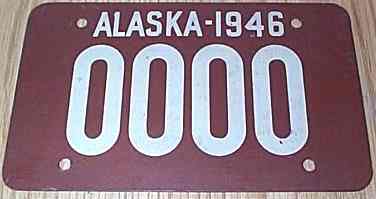
1946 issue- Fibreboard Sample Plate.
Approx. 5 1/2" x 8 5/8". White over maroon

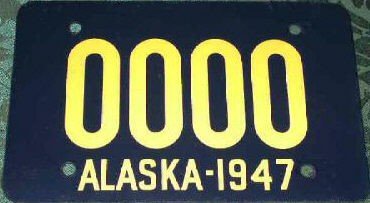
1947 issue- Fibreboard Sample Plate.
Approx. 5 1/2" x 8 5/8".
Yellow over Dark blue.
( Courtesy Dirk Starck)
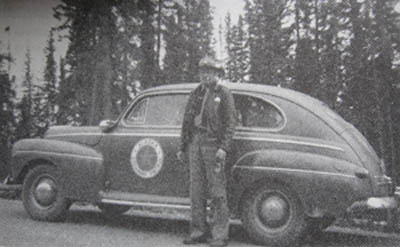 Alaska Highway Patrol-1947 Ford
Alaska Highway Patrol-1947 Ford
In 1948, Alaska resumed local production of embossed license plates, albeit using aluminum as opposed to the Pre-war steel plates. These new plates were made additionally attractive by adding an embossed rendition of the territorial flag on the left side of the plate which features the Big Dipper stellar constellation. The sample plates used by the Alaska Highway Patrol that year featured only three zeros as opposed to the four zeroes on the previous two issues. The fourth zero made a comeback the following year in 1949.
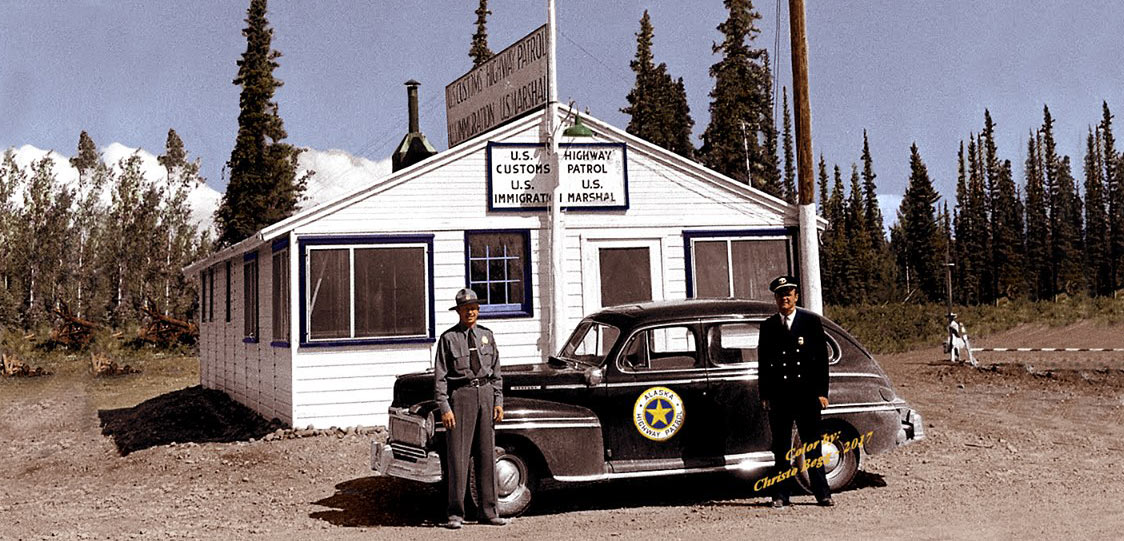 1948
1948 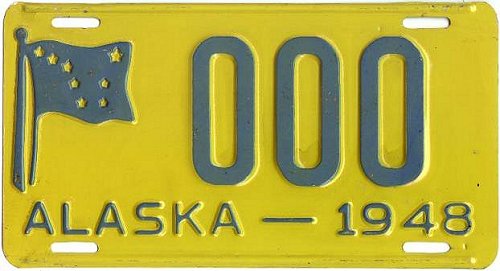 1949 issue- Embossed Aluminum Sample Plate.
1949 issue- Embossed Aluminum Sample Plate.
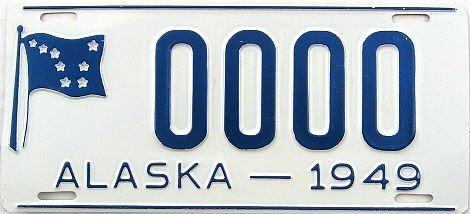 1949 issue- Embossed Aluminum Sample Plate.
1949 issue- Embossed Aluminum Sample Plate.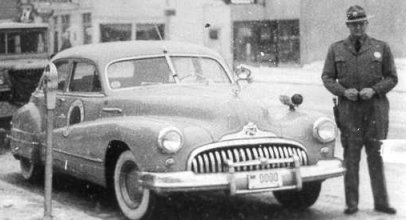 1949 AHP Buick
1949 AHP Buick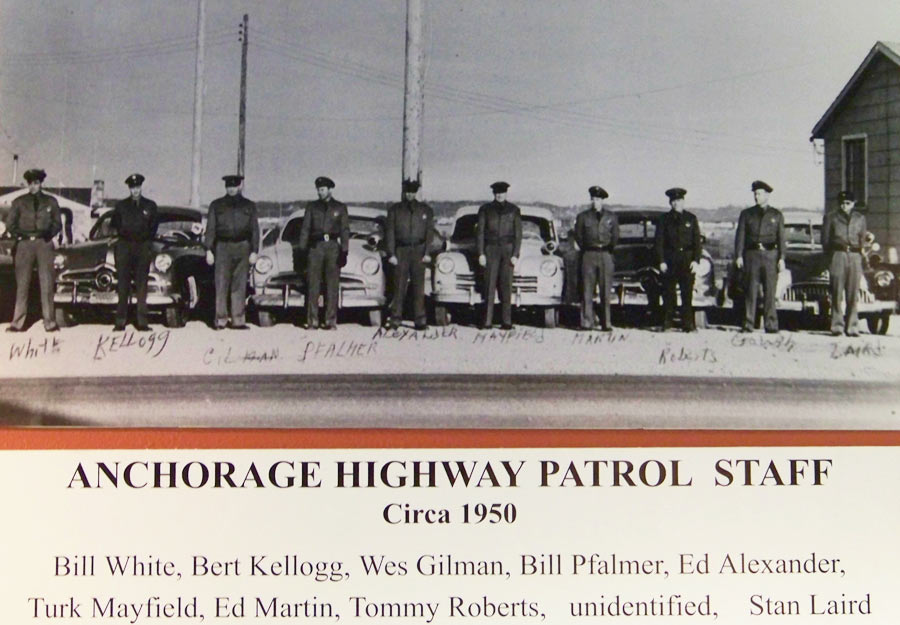
In 1950, steel license plates made a comeback in Alaska. The same layout with the territorial flag on the left side of the plate continued, however the increase in registered motor vehicles in the territory during this time necessitated an increase of registration digits to five, meaning a five-zero sample plate for the Highway Patrol. The resurrection of steel license plates in Alaska was short-lived as they were only used until the end of 1952.
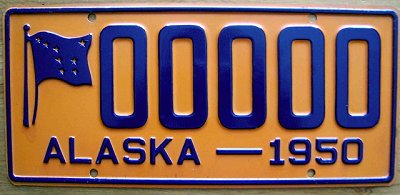 1950 issue- Embossed Steel Sample Plate
1950 issue- Embossed Steel Sample Plate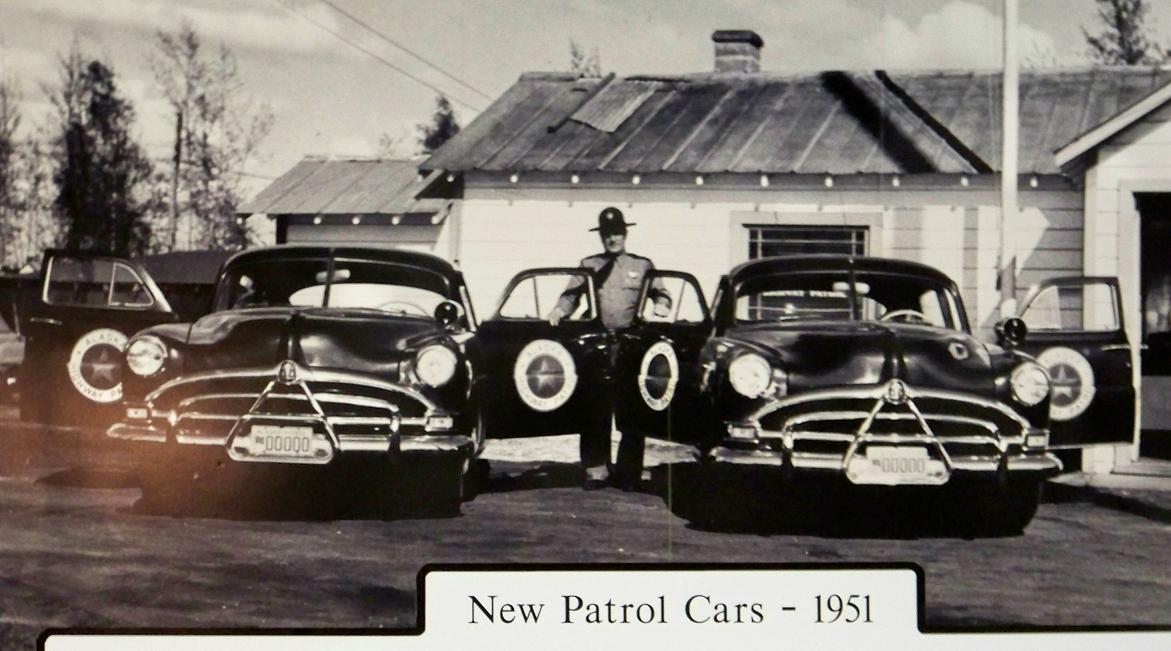

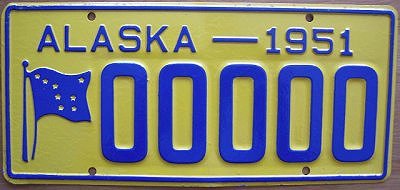 1951 issue- Embossed Steel Sample Plate
1951 issue- Embossed Steel Sample Plate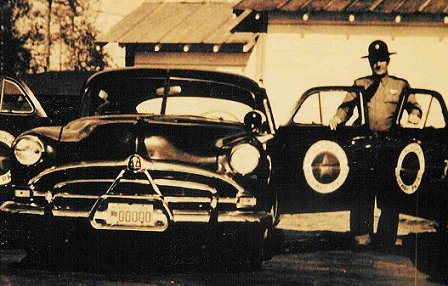 1951 Hudson Hornet
1951 Hudson Hornet
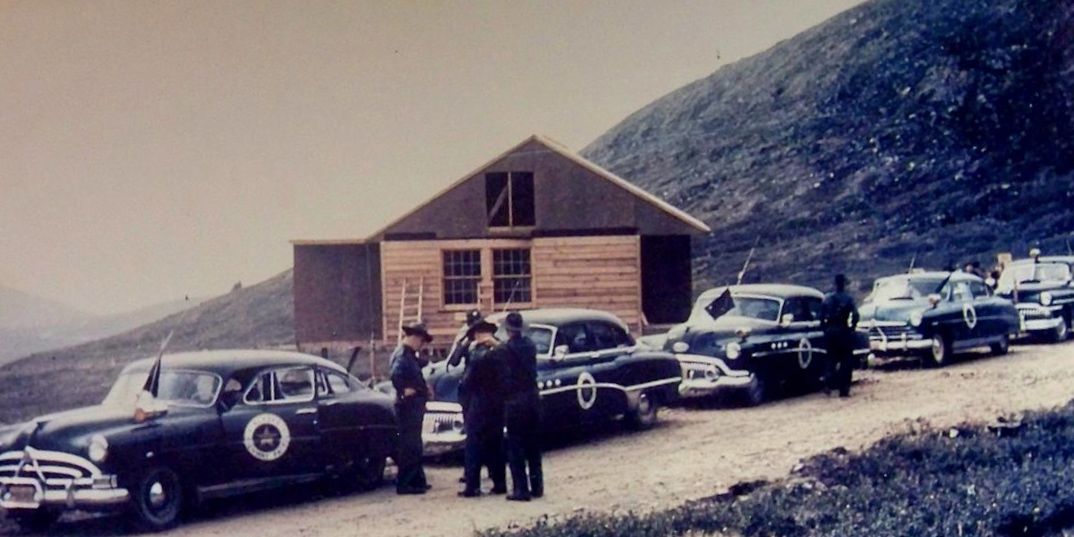
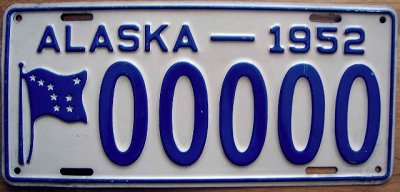 1952 issue- Embossed Steel Sample Plate
1952 issue- Embossed Steel Sample Plate 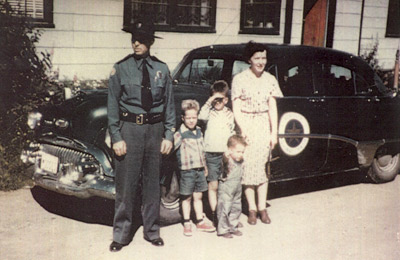 1952 AHP Buick
1952 AHP Buick
In 1953, a similar layout was used, but license plates were made out of aluminum again. In addition, instead of the year in full, only the last two digits of the year was in place in the upper right corner of the plate. On the left side of the 53 was a small round hole and a thin vertical slot positioned towards the bottom part of the 5. On the upper right side of the 3 was a thin vertical slot and a small round hole. These elements were installed to accommodate future annual validation tabs, making this Alaska's first "multi year" license plate. These plates were used on Alaska Territorial Police vehicles until the end of 1955.
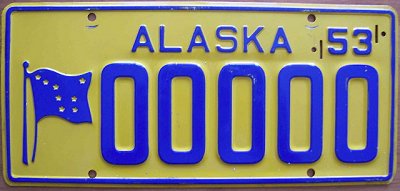 1953-1955 issue-
1953-1955 issue-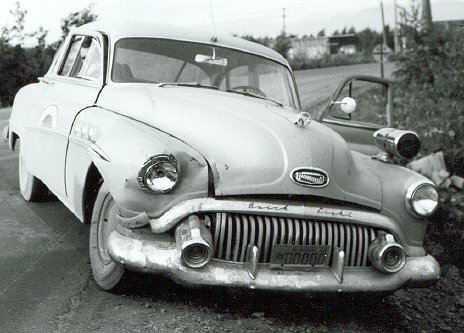
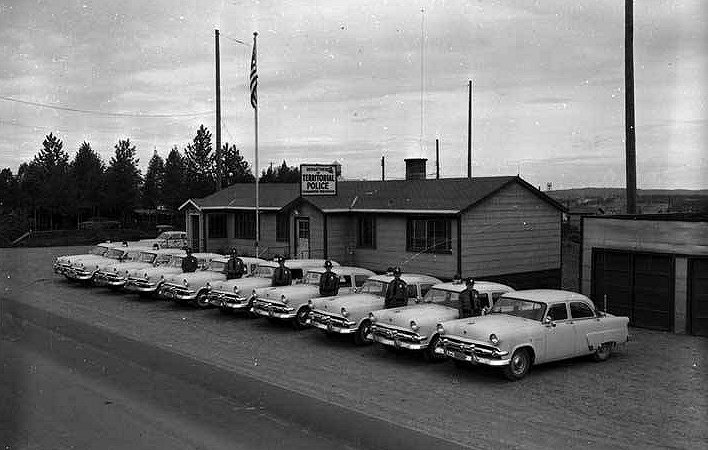
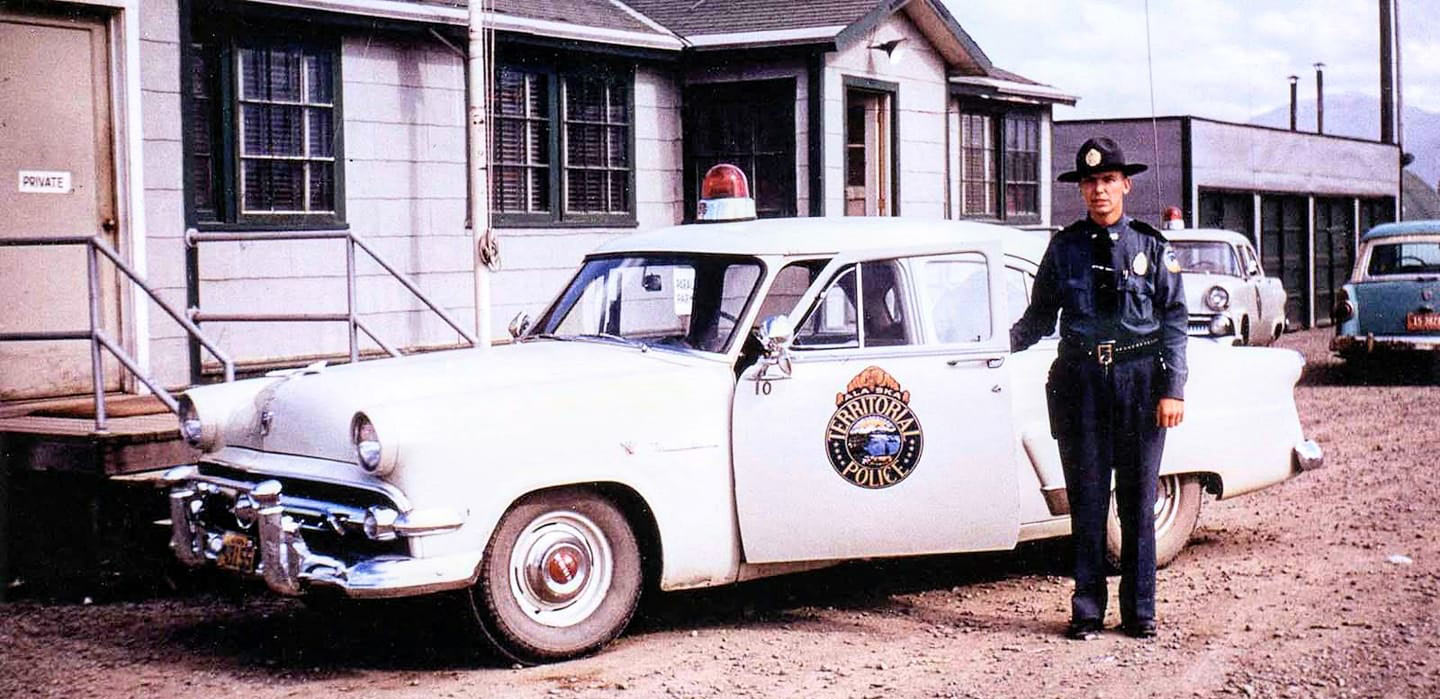
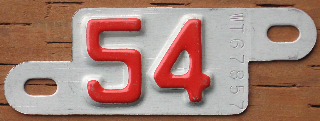 1954 Embossed Aluminum Validation Tab
1954 Embossed Aluminum Validation Tab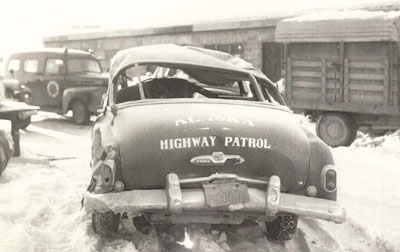 Larger view of this photo available in Gallery below
Larger view of this photo available in Gallery below
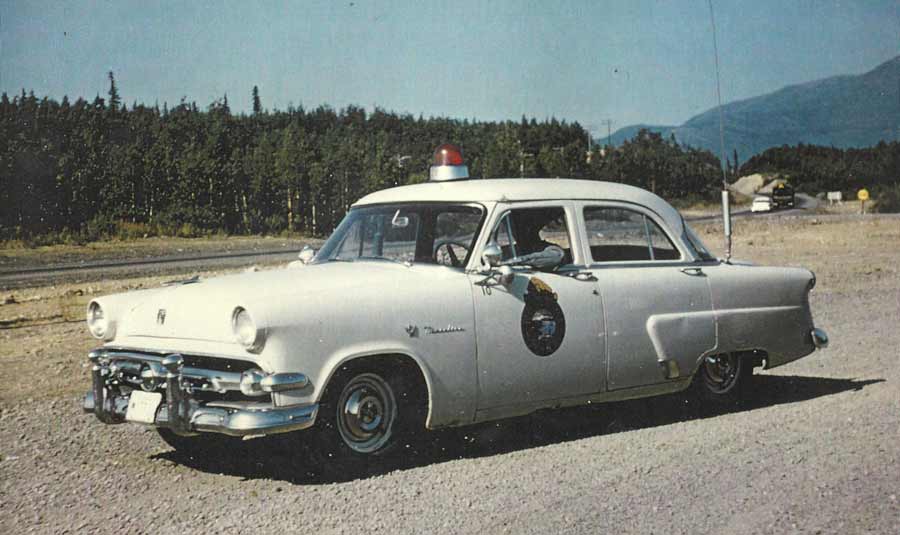
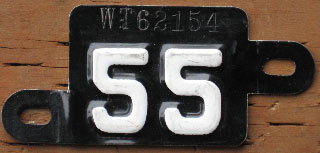 1955 Embossed Aluminum Validation Tab
1955 Embossed Aluminum Validation Tab 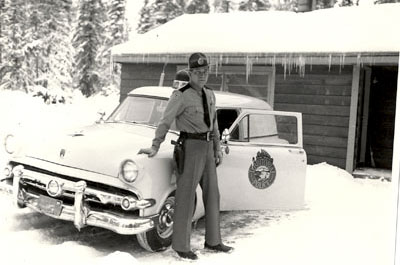 Larger view of this photo available in Gallery below
Larger view of this photo available in Gallery below
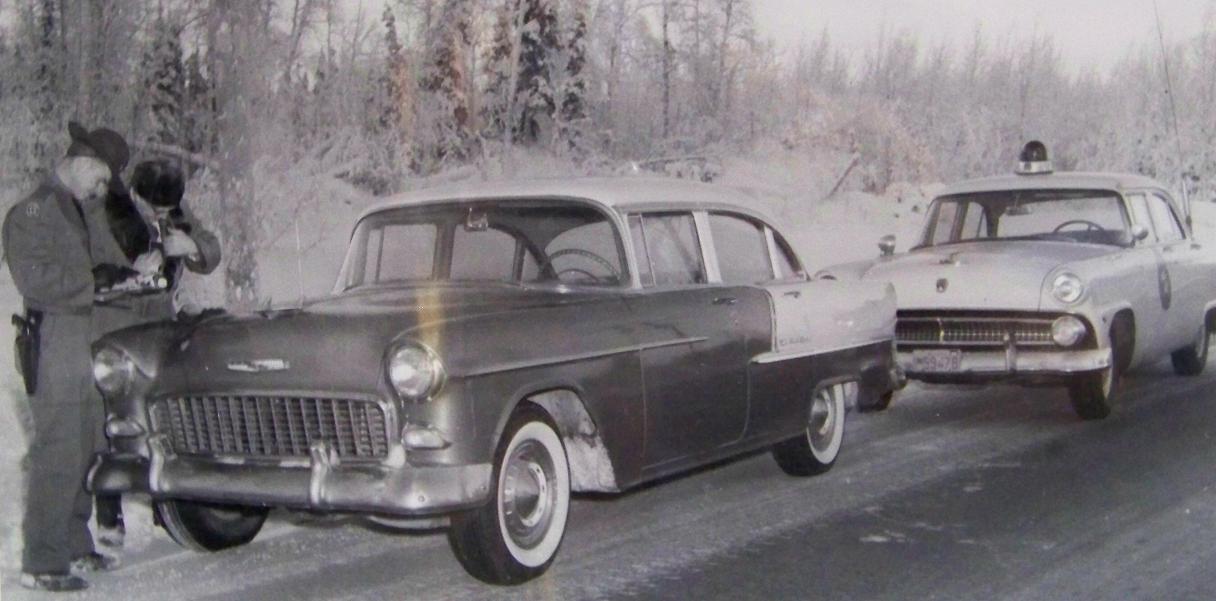
In 1956, the Alaska Territorial Police began using regular passenger car license plates on their marked patrol vehicles. The plates were made of embossed aluminum and were in the new standard size format of 6" x 12". The state name was embossed at the top center between the upper mounting holes. In the top right corner was embossed 56 for the year and it was flanked by the same vertical slot and hole pattern as the previous issue on each side to accommodate future validation tabs. The left center of the plate featured once again the flag of the territory followed by a four to five digit registration number. The plate has a flat white background with embossed characters painted in dark blue. The plates were issued in random number blocs. Some ATP plates have been seen in the 1000 number bloc, some in the 30000 number bloc and others in the 59000 number bloc. The plates were validated in 1957 with a white on red embossed aluminum validation tab.
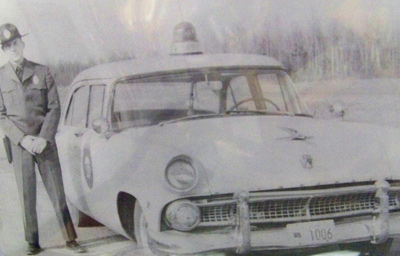 1956 issue. Blue over white. Number 1006
1956 issue. Blue over white. Number 1006
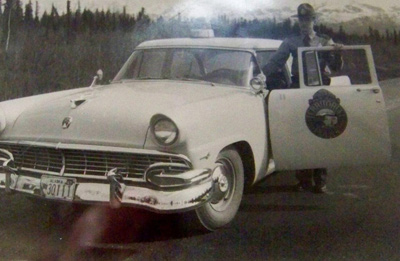 1956 passenger plate number 30111 with 1957 validation tab
1956 passenger plate number 30111 with 1957 validation tab
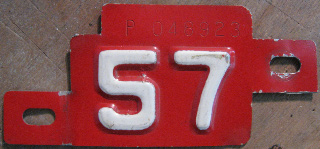 1957 Embossed Aluminum Validation Tab
1957 Embossed Aluminum Validation Tab 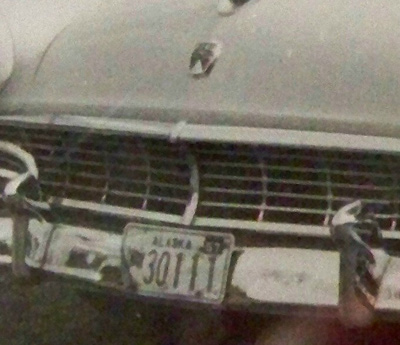
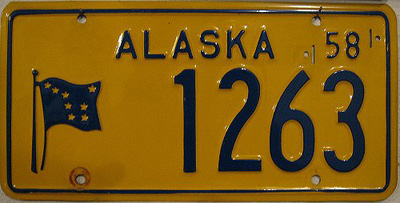 1958-1959 issue-Embossed Aluminum in 1000 Number Bloc- Dark blue over yellow.
1958-1959 issue-Embossed Aluminum in 1000 Number Bloc- Dark blue over yellow. 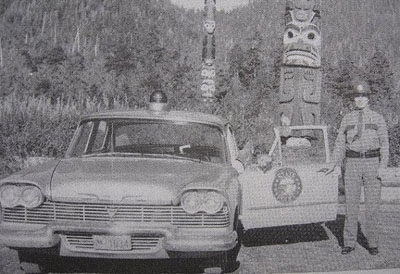 1958 plate number 1034
1958 plate number 1034
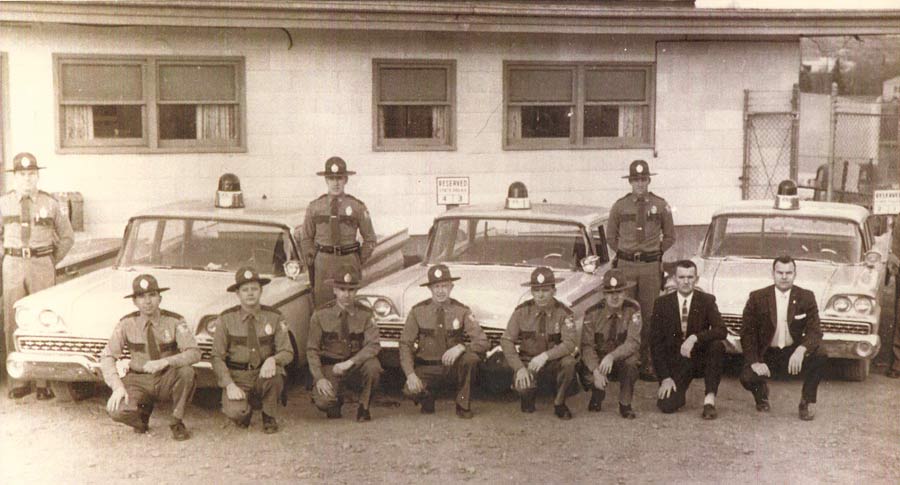 "Thanks a lot for blocking all the plates for the photo, guys!....sheesh..."
"Thanks a lot for blocking all the plates for the photo, guys!....sheesh..."
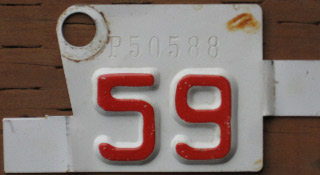 1959 Embossed Aluminum Validation Tab
1959 Embossed Aluminum Validation Tab 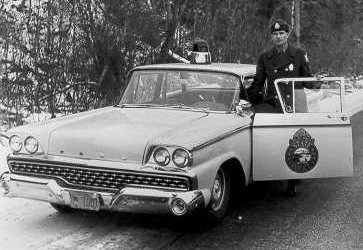 1959 ASP Ford with plate number 1001
1959 ASP Ford with plate number 1001
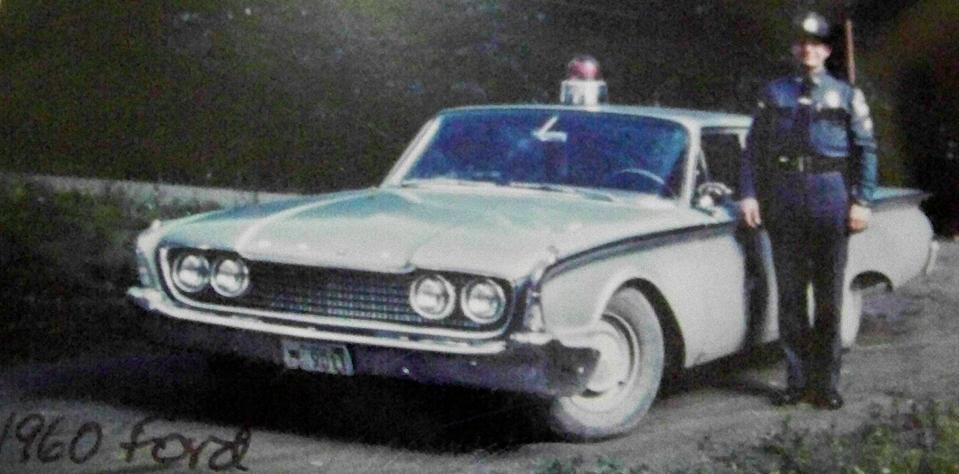
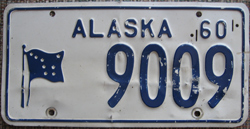 1960-1961 issue- Embossed Aluminum in 9000 Number Bloc-Dark blue over white.
1960-1961 issue- Embossed Aluminum in 9000 Number Bloc-Dark blue over white.
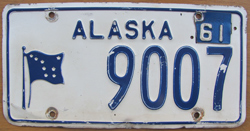 1960-1961 issue-Embossed Aluminum in 9000 Number Bloc with 1961 Validation Tab
1960-1961 issue-Embossed Aluminum in 9000 Number Bloc with 1961 Validation Tab
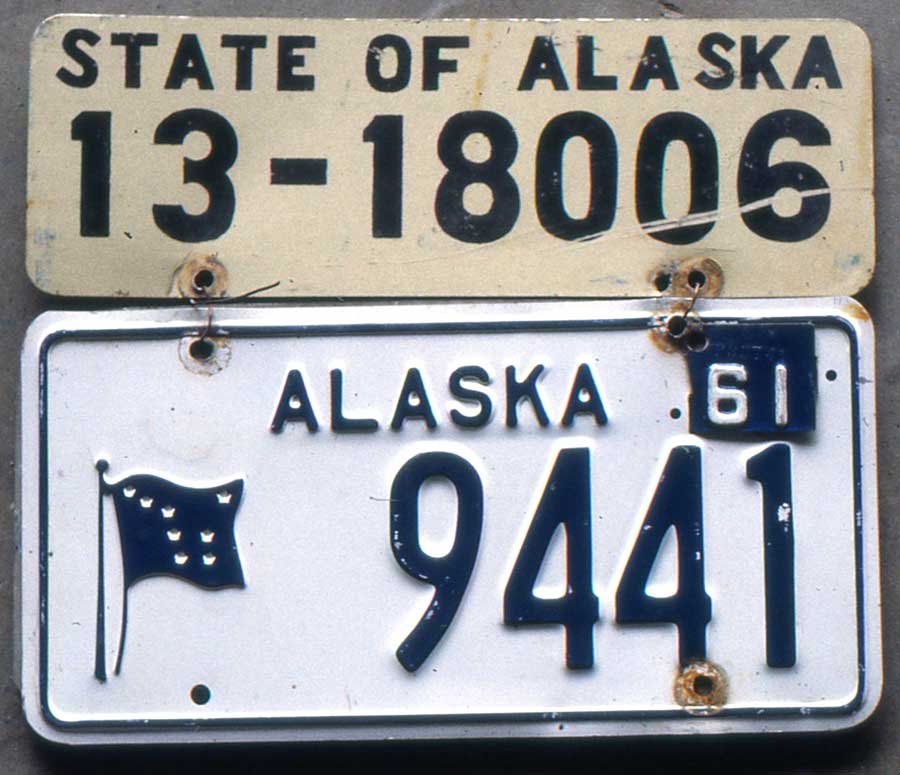 1960-1961 issue with State Vehicle identification plate
1960-1961 issue with State Vehicle identification plate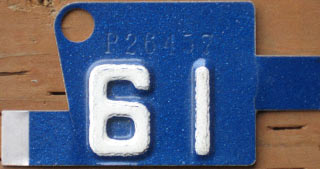 Embossed Aluminum Validation Tab
Embossed Aluminum Validation Tab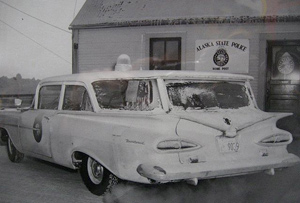 1961 ASP Chevrolet wagon- Plate # 9039
1961 ASP Chevrolet wagon- Plate # 9039
In 1962 a new OFFICIAL USE ONLY license plate was introduced and used until 1975. The plate was dark blue over reflective yellow and made of embossed aluminum (Painted raised border) OFFICIAL USE ONLY embossed along the top and under the upper bolt-holes. The embossed state flag on the left of the plate followed by a 4-digit number in the 1-600 number bloc for the earliest years and up to 2-#### for the latest in the series into 1975. ALASKA embossed between the lower bolt-holes.
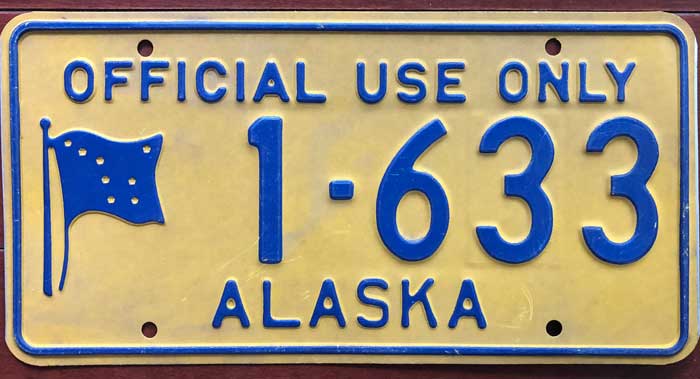 1962-1975 Base. Embossed aluminum.
1962-1975 Base. Embossed aluminum. 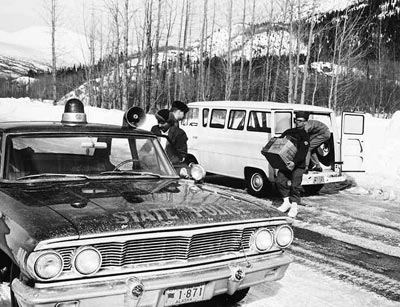
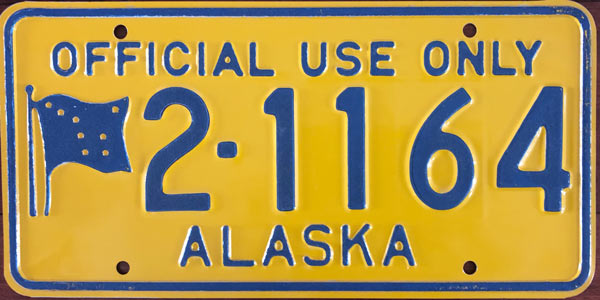 1962-1975 Base. Embossed aluminum.
1962-1975 Base. Embossed aluminum. 
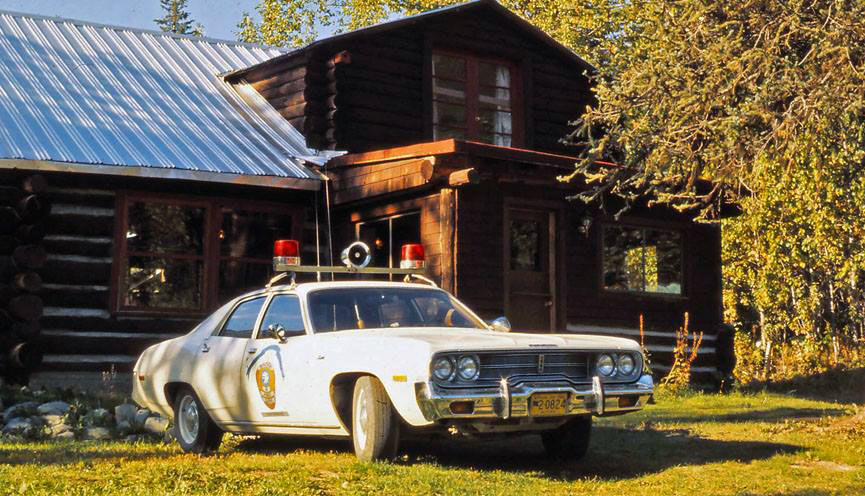 Circa 1972 - In the 2-0800 series at that time.
Circa 1972 - In the 2-0800 series at that time. 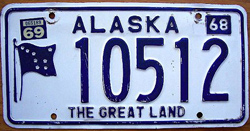 1968-1969 plate that was used on unmarked Service Section car of Captain D. McQueen-Court Service.
1968-1969 plate that was used on unmarked Service Section car of Captain D. McQueen-Court Service.
In 1976, Alaska began issuing attractive graphic license plates for the U.S. Bicentennial. The plates had ALASKA embossed in red along the top between the upper bolt-holes over embossed registration number that commenced with an AST prefix and up to 3 numbers. The word TROOPERS was embossed in small dies on the bottom of the plate. The graphics on the plate feature a standing brown bear in the center and mountain scene in the background. A blue square with 76 surrounded by a circle of 5-point stars is in the upper right corner of the plate. Step border used on this base. These plates were sometimes validated with annual stickers in upper corners. These plates were used until 1982.
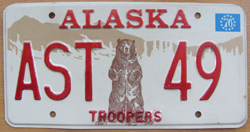 1976-1982 issue Bicentennial Base. Embossed aluminum.
1976-1982 issue Bicentennial Base. Embossed aluminum.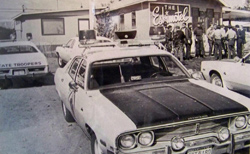 Larger view of this photo available in Gallery below
Larger view of this photo available in Gallery below
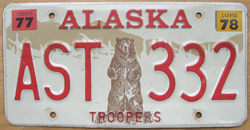 1976-1982 issue Bicentenial Base. Embossed aluminum.
1976-1982 issue Bicentenial Base. Embossed aluminum.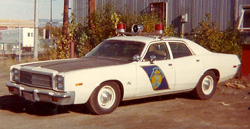 1978 Plymouth Fury
1978 Plymouth Fury
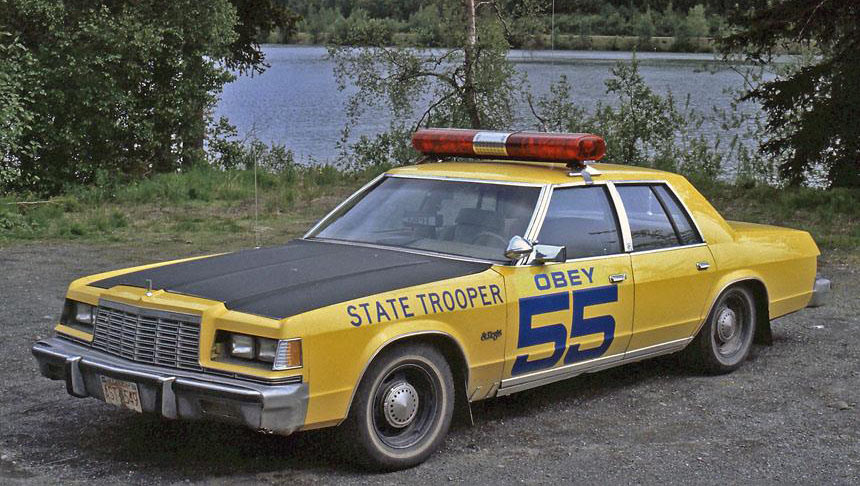 1981
1981 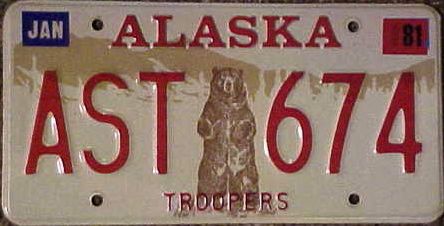 1976- 1982 issue Bicentennial base.
1976- 1982 issue Bicentennial base. 
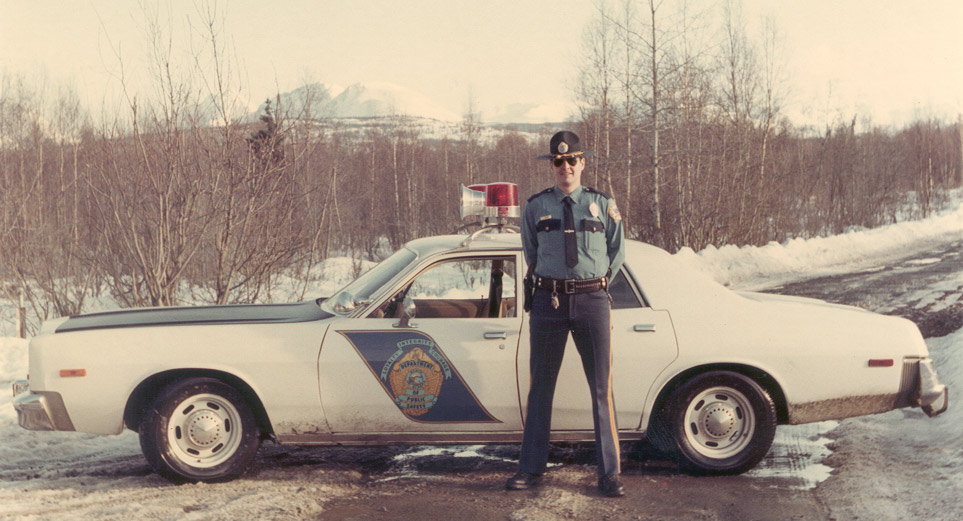
In 1982, new blue over reflective yellow plates were issued to Alaska State Troopers. The state name was silk-screened between the upper bolt-holes above an embossed registration number that commenced with an AST prefix and up to 3 numbers. The letters and numbers were separated by a silk-screened graphic of the state flag. The word TROOPERS was embossed in small dies on the bottom of the plate. Most AST plates had one white over blue sticker with the words STATE over VEHICLE and a similar sticker with the letter P indicating that the plate was a Permanent issue. These stickers were placed in each top corner and varied from left or right.
Around 1991, the same plate was still used, but the AST went to the suffix position.
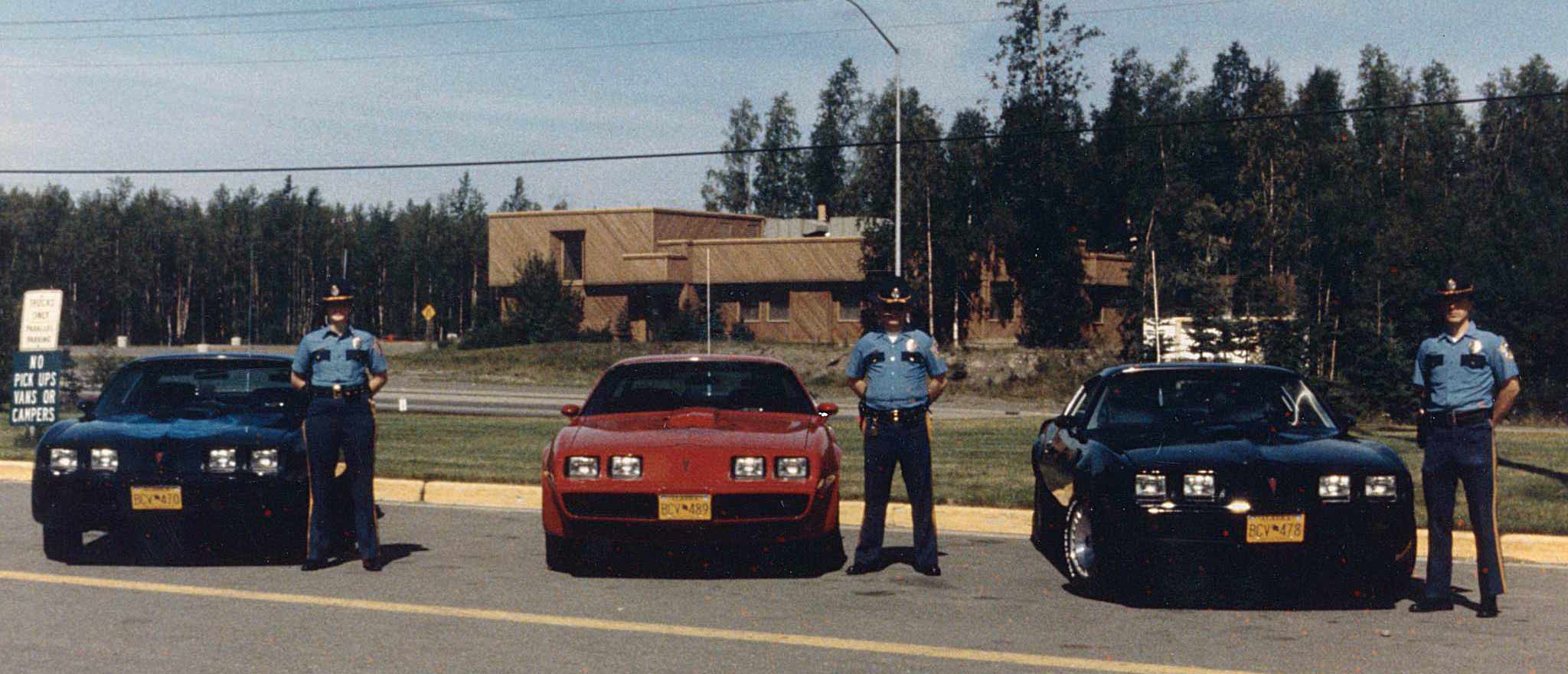 1981 Plain car detail in unmarked 1981 Pontiac Trans Ams using BCV 400 series passenger plates.
1981 Plain car detail in unmarked 1981 Pontiac Trans Ams using BCV 400 series passenger plates. 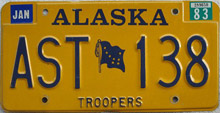 1982-Early 1990's issue. Embossed aluminum.
1982-Early 1990's issue. Embossed aluminum. 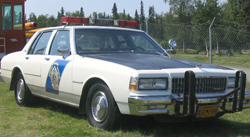 1987 Chevrolet Caprice
1987 Chevrolet Caprice
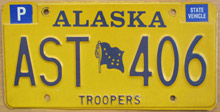 1982-Early 1990's issue. Embossed aluminum.
1982-Early 1990's issue. Embossed aluminum. 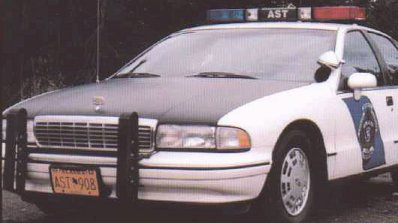 1991 Chevrolet Caprice
1991 Chevrolet Caprice
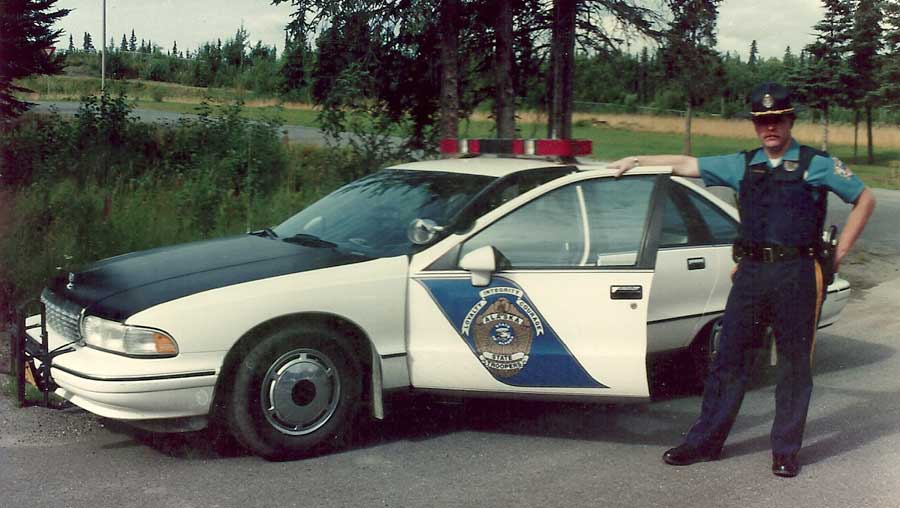
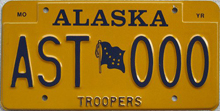 1982-Early 1990's Sample issue. Embossed aluminum. Dark blue over reflective yellow/gold. No Decals affixed. AST in prefix position followed by three zeroes.
1982-Early 1990's Sample issue. Embossed aluminum. Dark blue over reflective yellow/gold. No Decals affixed. AST in prefix position followed by three zeroes.
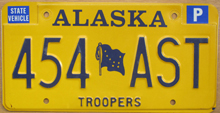 1990's-2004 issue. Embossed aluminum.
1990's-2004 issue. Embossed aluminum. 
Around 2001, a graphic design front plate began gracing the "business end" of AST patrol cars. The plates had similar colors to the rear plates but were all silk-screened with the exception of TROOPERS embossed in small dies along the bottom of the plate. The center of the plate reads: ".08 It's the Law" indicating Alaska's maximum allowable blood alcohol content for driving a motor vehicle.
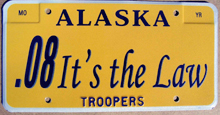 2001 issue front plate. Embossed aluminum.
2001 issue front plate. Embossed aluminum. 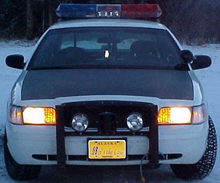
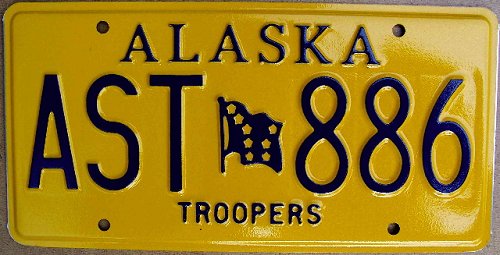 2005 ERROR issue. Embossed aluminum.
2005 ERROR issue. Embossed aluminum.
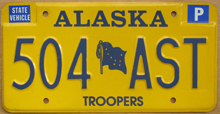 Circa 2006 issue. Embossed aluminum.
Circa 2006 issue. Embossed aluminum. 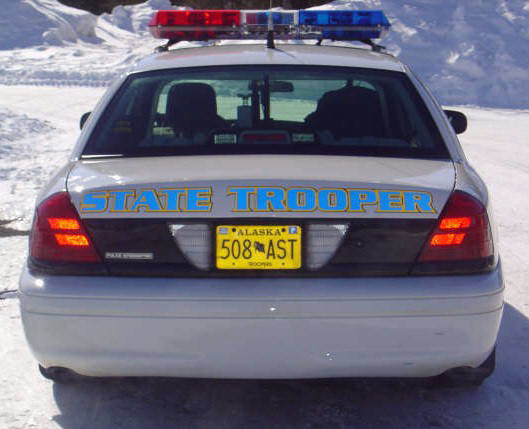
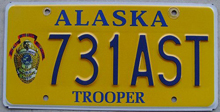 2006-Current issue with AST in suffix position. Embossed aluminum. Dark blue over reflective yellow-gold. Features full-color Alaska DPS badge design at center left. Numbering is three numbers followed by AST (no separation of numbers to letters)
2006-Current issue with AST in suffix position. Embossed aluminum. Dark blue over reflective yellow-gold. Features full-color Alaska DPS badge design at center left. Numbering is three numbers followed by AST (no separation of numbers to letters)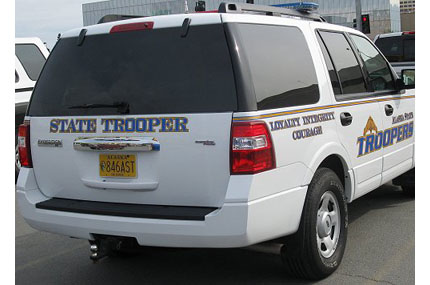 (Courtesy Dirk Starck)
(Courtesy Dirk Starck)
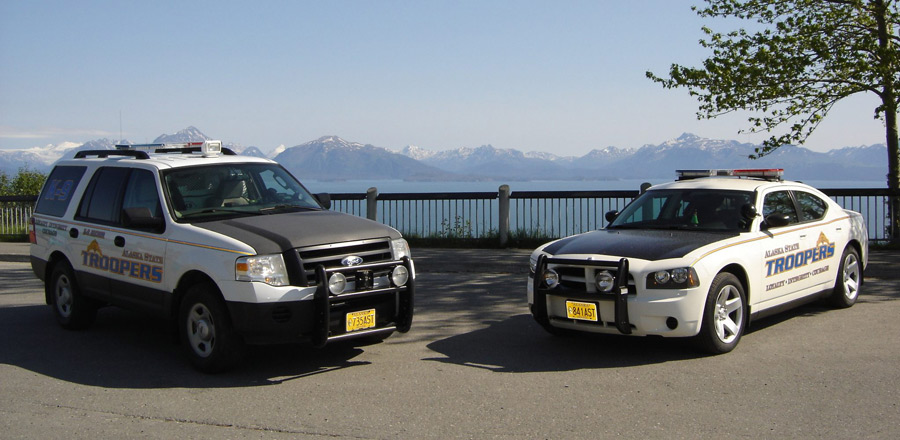
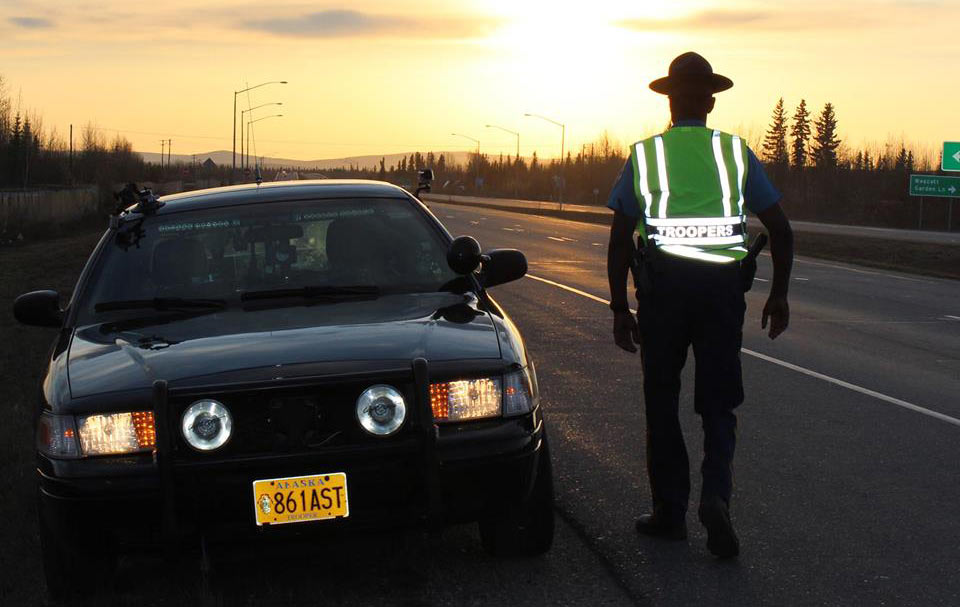 (Courtesy Jim Aitken)
(Courtesy Jim Aitken) Sometime around 2016, Alaska State Troopers license plates switched back to the AST as a prefix.
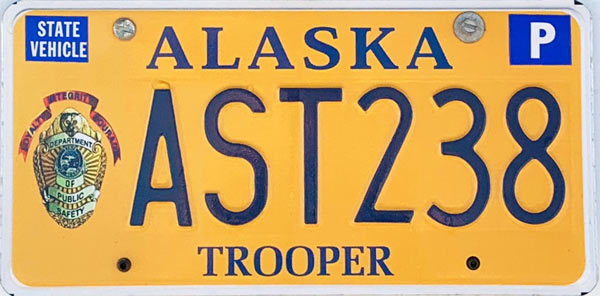 Circa 2016-Current issue with AST in prefix position.
Circa 2016-Current issue with AST in prefix position.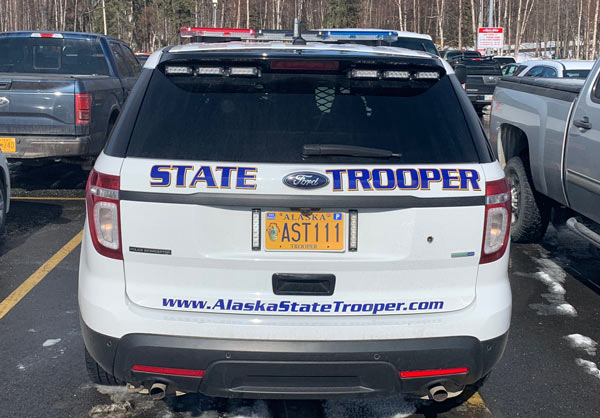 (Courtesy of Alex Ginzburg)
(Courtesy of Alex Ginzburg)
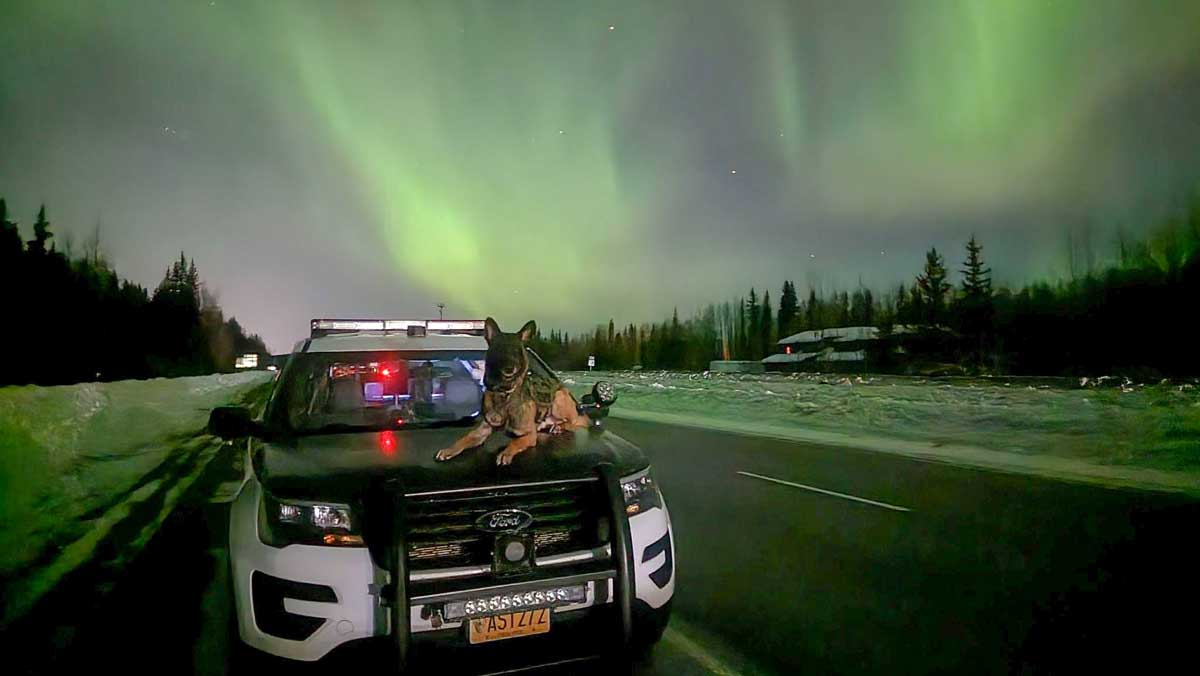 (Courtesy of Trooper Hibbs)
(Courtesy of Trooper Hibbs)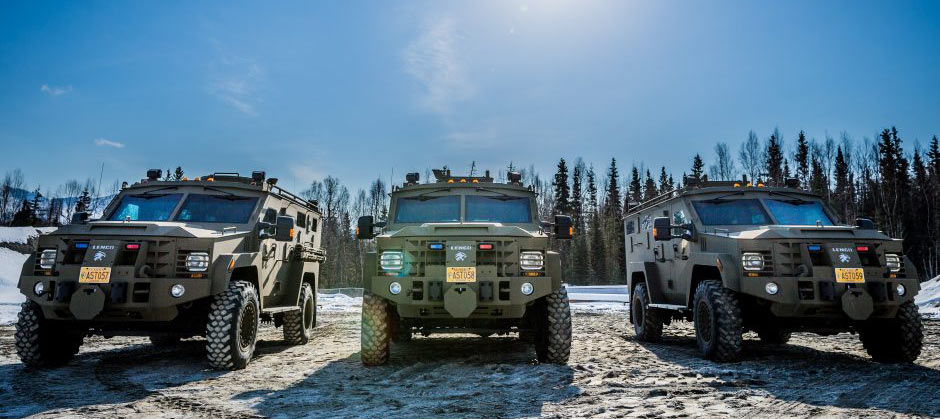
The following are unofficial specialty and novelty types not for use on duty.
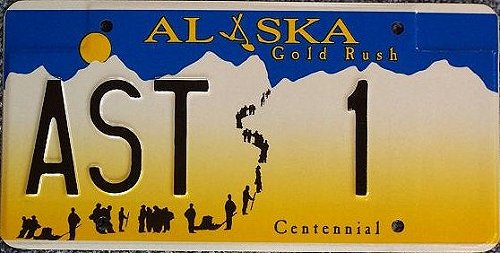 1998 Prototype issue. Embossed aluminum.
1998 Prototype issue. Embossed aluminum. 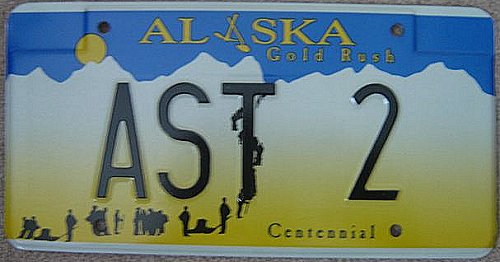 1998 Prototype issue with Deputy Commissioner's assignment number
1998 Prototype issue with Deputy Commissioner's assignment number
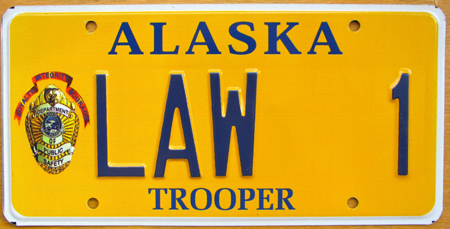 2006 issue-Embossed aluminum.
2006 issue-Embossed aluminum. 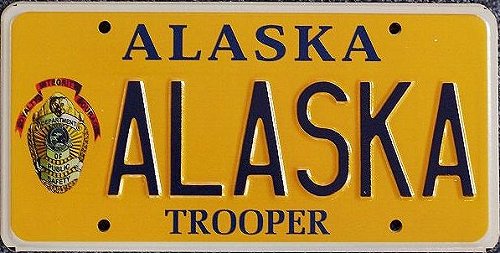 2006 issue-Embossed aluminum.
2006 issue-Embossed aluminum. 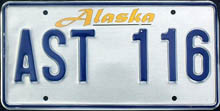 1990's Prototype using Arizona dies.
1990's Prototype using Arizona dies. 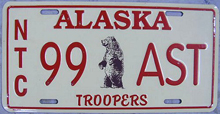 1999 National Trooper's Coalition Souvenir. Embossed thin aluminum. Red over cream.
1999 National Trooper's Coalition Souvenir. Embossed thin aluminum. Red over cream. I am going to be brutally honest here. I have absolutely no confirmed information with respect to early Alaska State Troopers motorcycle usage with the excpetion of the photos below. If you have any info on its formation, deployment and how long it was in place before being canceled, I would love to know!
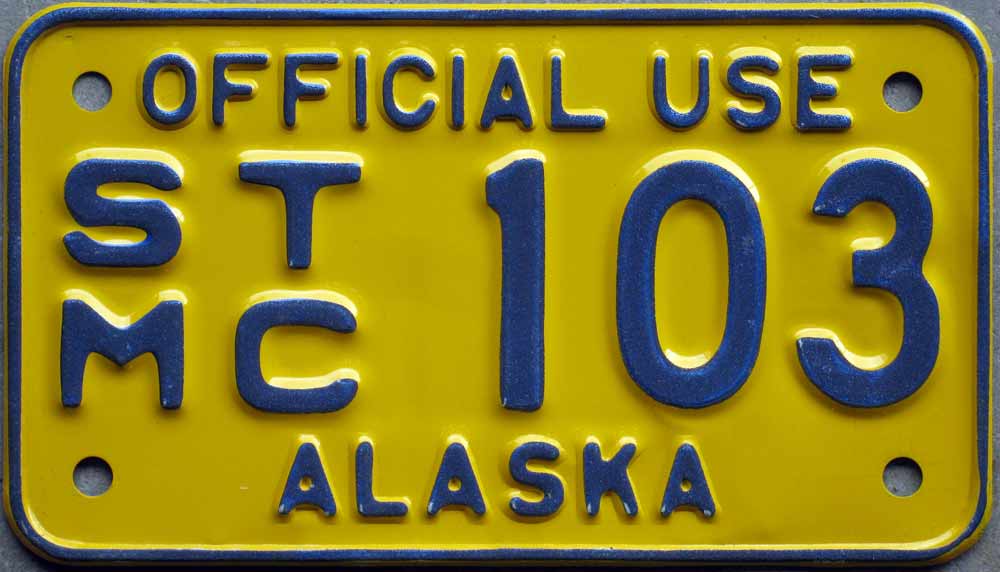 1973 issue State Motorcycle. Embossed aluminum.
1973 issue State Motorcycle. Embossed aluminum.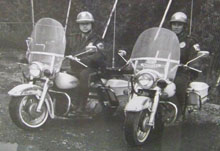 Early Alaska Motors
Early Alaska Motors
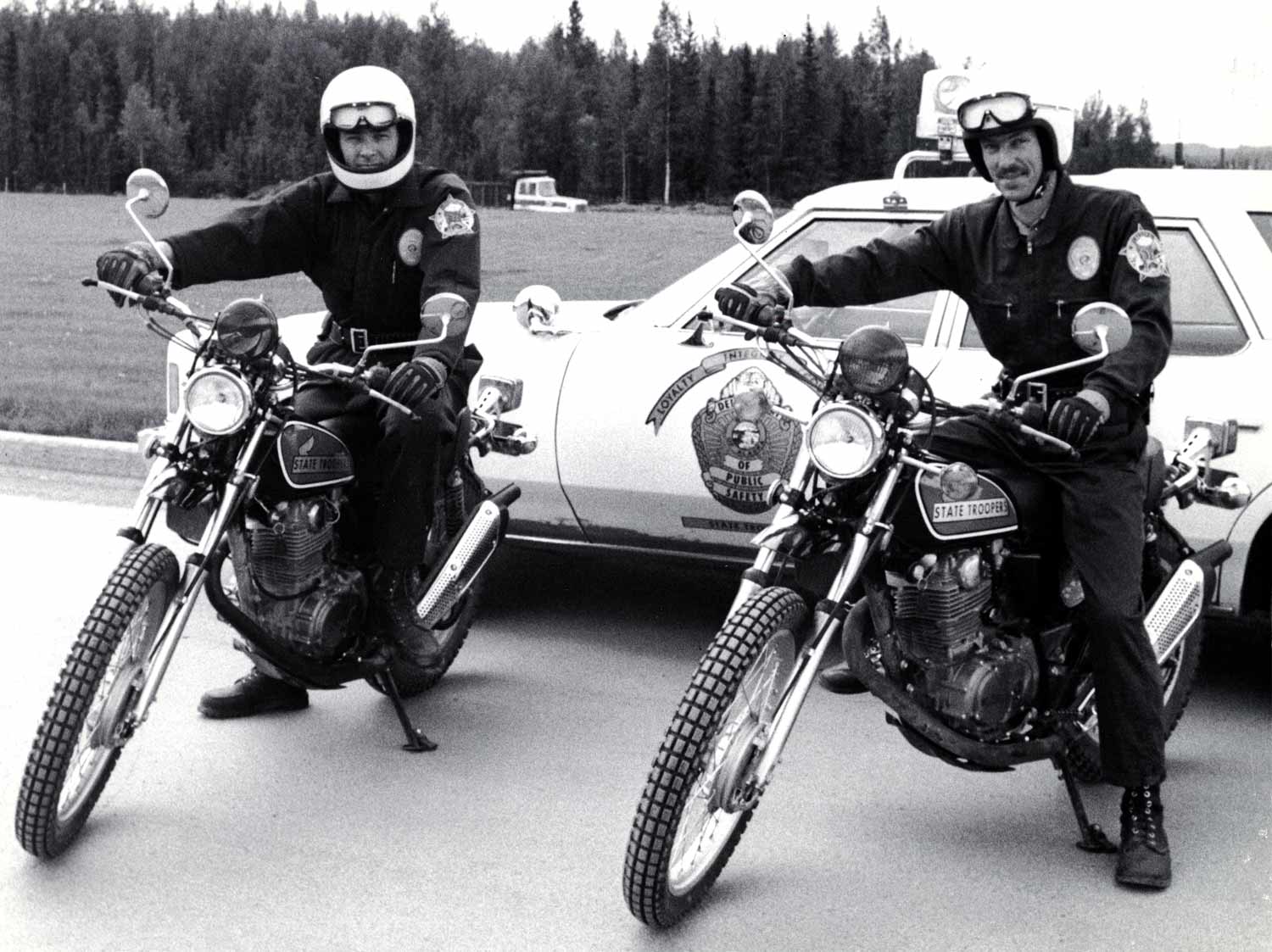 1978...of course, nobody thought to take a photo of the BACK of these motorcycles...
1978...of course, nobody thought to take a photo of the BACK of these motorcycles...
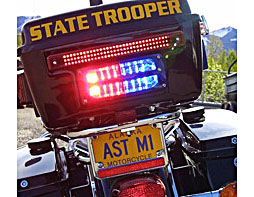
The Alaska State Troopers recently re-commissioned its Motor Unit. A pilot program in 2007 brought 4 Harley-Davidson Road Kings to the Juneau HQ. They are used during the summer months for security escort and traffic enforcement in high density areas.
The Alaska Fish And Wildlife Protection Trooper's primary mission is the protection of Alaska's fish and wildlife resources through enforcement of laws and regulations governing use of natural resources within Alaska and its adjacent waters, as well as through increasing the knowledge of, and respect for, fish and wildlife laws and regulations.
The Alaska Bureau of Wildlife Enforcement also participates in the overall mission of the Department of Public Safety through enforcement of criminal laws and participation in Search and Rescue operations. The State of Alaska has 586,412 square miles or approximately 365,000,000 acres and 47,300 miles of coastline. All this area is covered by approximately 89 Bureau of Wildlife Enforcement State Troopers. This means there is only one trooper for every 6,588 square miles. Some folks argue that these FWP Troopers are even tougher and more stringent than "regular" AST Troopers, but I guess it decides which side of the argument you're on when you make that decision!
Alaska Bureau of Wildlife Enforcement Trooper plates have mirrored the regular AST plate issuances with the exception of FWP prefixes and the word PROTECTION embossed in small dies at the bottom of the plate.
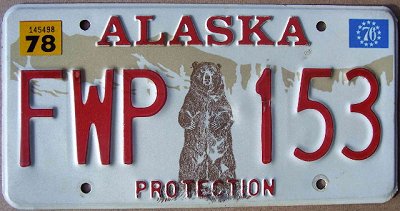 1976-1982 issue- Embossed aluminum.
1976-1982 issue- Embossed aluminum. 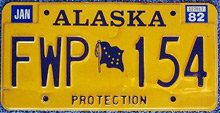 1982-1990's issue. Embossed aluminum.
1982-1990's issue. Embossed aluminum. 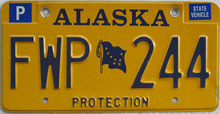 1982-1990's issue. Embossed aluminum.
1982-1990's issue. Embossed aluminum. 